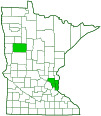European crane fly
(Tipula paludosa)
Conservation • Description • Habitat • Ecology • Distribution • Taxonomy
Conservation Status |
|
|||
| IUCN Red List | not listed |
|||
| NatureServe | not listed |
|||
| Minnesota | not listed |
|||
Description
European crane fly is a large, exotic, invasive, crane fly. It is native to northwestern Europe. It was first reported in North America in 1955 in Nova Scotia. Separate populations were found in British Columbia in 1965 and in Ontario in 1996. It has since spread rapidly and now occurs throughout the United States. It is still uncommon in the upper Midwest, including in Minnesota. Adults are found from late July to September in nurseries, sod farms, golf courses, agricultural crops, hay fields, lawns, and gardens. They do not feed. Larvae, called leatherjackets, are found in the top three inches of soil. They feed on the roots of grasses and a variety other plants.
Adults are slender, soft-bodied, yellowish-brown, and 1″ to 1 3⁄16″ (2.5 to 3.0 cm) in length. They look like oversize mosquitoes.
There are two large compound eyes on the sides of the head and no simple eyes (ocelli). The compound eyes are bare, not covered with hairs. The gap between the compound eyes on the underside of the head is wide. The mouth parts are at the end of a short but conspicuous, snout-like projection (rostrum) on the front of the head. At the tip of the rostrum, on the upper side, there is a short pointed extension (nasus). The lower jaws (maxillae) have long sensory structures (palps) attached. Each palp has four segments. The fourth segment is antennae-like and very long, longer than first three segments combined. The antennae are short and have 14 segments. The segments are simple, not branched. Each segment has a whorl of long hairs at the base.
The upper thoracic plate (mesonotum) is brownish-gray with dull, darker gray, longitudinal stripes. It has a distinct, V-shaped groove (suture) on top near the wing bases.
The abdomen is long and slender, and has nine evident segments. Each segment is yellowish-brown with a dark, upper (middorsal), longitudinal stripe, and a small dash-like spot on each side of the stripe. The last abdominal segment on the female has a long, acutely pointed, egg-laying apparatus (ovipositor). On the male, the last segment is enlarged into a club-shaped structure (hypopygium) that supports the copulatory apparatus.
The wings are tinted grayish-brown. There is a narrow dark stripe on the leading edge (costal margin), and a narrow pale stripe just inside the dark stripe. The radius vein (R) has three branches. There are two anal veins, both of them long and reaching the wing margin. On the female, the wings do not reach the tip of the abdomen.
The legs are long and slender. The fourth leg segment (tibia) of each leg has two spurs at the tip.
Size
Total length: 1″ to 1 3⁄16″ (2.5 to 3.0 cm)
Similar Species
Habitat
Nurseries, sod farms, golf courses, agricultural crops, hay fields, lawns, and gardens
Ecology
Season
Late July to September
Behavior
The wings are held spread at almost right angles when at rest.
Life Cycle
Larva Food/Hosts
Roots of a variety of grasses and other plants
Adult Food
Adults do not feed
Distribution |
||
|
Sources |
|
| 10/1/2025 | ||
Occurrence |
||
Does not occur in Minnesota |
||
Taxonomy
Order
Suborder
Nematocera
Infraorder
Superfamily
Tipuloidea (Typical Crane Flies)
Family
Subfamily
Genus
Subgenus
Tipula (European crane flies)
Subordinate Taxa
Synonyms
Tipula fimbriata
Tipula flavolutescens
Tipula submensoda
Tipula wollastoni
Common Names
common European crane fly
European crane fly
Glossary
Costal margin
The leading edge of the forewing of insects.
Mesonotum
The principal exoskeletal plate on the upper (dorsal) part of the middle segment of the thorax of an insect.
Ocellus
Simple eye; an eye with a single lens. Plural: ocelli.
Ovipositor
A tube-like organ near the end of the abdomen of many female insects, used to prepare a place for an egg and to place the egg.
Palp
Short for pedipalp. A segmented, finger-like process of an arthropod; one is attached to each maxilla and two are attached to the labium. They function as sense organs in spiders and insects, and as weapons in scorpions. Plural: palpi or palps.
Rostrum
The stiff, beak-like projection of the carapace or prolongation of the head of an insect, crustacean, or cetacean.
Tibia
The fourth segment of an insect leg, after the femur and before the tarsus (foot). The fifth segment of a spider leg or palp. Plural: tibiae.
Visitor Photos
Share your photo of this insect.
This button not working for you?
Simply email us at info@MinnesotaSeasons.com.
Attach one or more photos and, if you like, a caption.
|
||
MinnesotaSeasons.com Photos
|

Slideshows

Visitor Videos
Share your video of this insect.
This button not working for you?
Simply email us at info@MinnesotaSeasons.com.
Attach a video, a YouTube link, or a cloud storage link.
Other Videos
TIPULA PALUDOSA
Michel-Marie Solito de Solis
TIPULA PALUDOSA{DADDY-LONG-LEGS]
MrElephant47
Tipula paludosa
A beautiful day

Visitor Sightings
Report a sighting of this insect.
This button not working for you?
Simply email us at info@MinnesotaSeasons.com.
Be sure to include a location.
Minnesota Seasons Sightings

